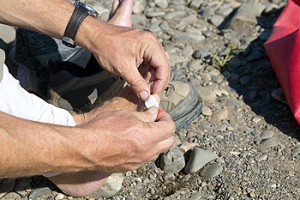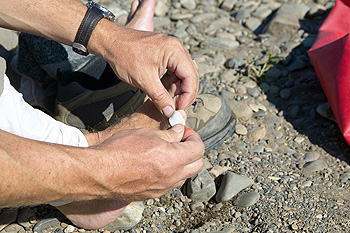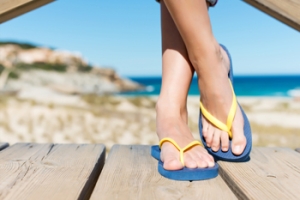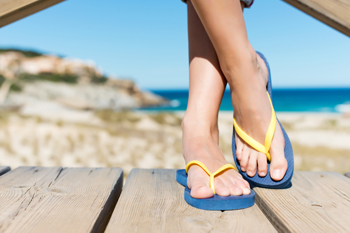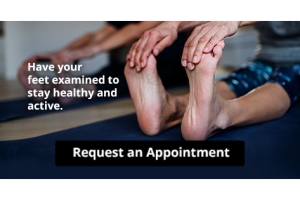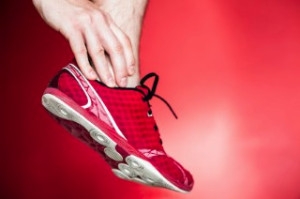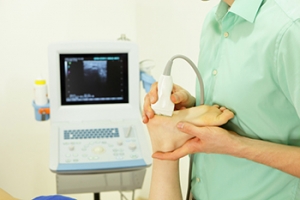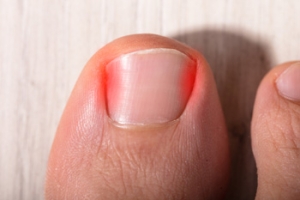Connect With Us
Blog

Prepping Your Feet for a Healthy Hike
Preparing your feet for a hike can help you to prevent an injury and make your excursion more relaxing and enjoyable. Start with a pair of comfortable hiking boots or shoes that provide plenty of room in the toe box and ensure that the feet don’t slip out of the shoes at the heel or arch area. It is also important to gradually break the boots in before going on a long hike. Choose moisture-wicking socks, or even toe-socks that separate the toes—preventing them from rubbing together and possibly even helping to distribute your weight more evenly. Bring an extra pair of socks to switch out if your feet get too sweaty or wet during the hike. Before you hit the trail, do some gentle stretching in your bare feet such as rolling your arches on a tennis ball, stretching out your toes, circling your ankles slowly, and stretching your calves. If you have spots on your feet that are prone to blistering, apply some tape, moleskin, or a bandage to the area, and pack extra supplies to apply to any hotspots you start feeling on the trail. For advice on choosing shoes or getting custom orthotics that are best for your specific feet on or off the trail, please consult with a podiatrist today.
Exercising your feet regularly with the proper foot wear is a great way to prevent injuries and build strength. If you have any concerns about your feet, contact Mark Isenberg, DPM from Center for Podiatric Excellence. Our doctor can provide the care you need to keep you pain-free and on your feet.
Exercise for Your Feet
Exercise for your feet can help you gain strength, mobility and flexibility in your feet. They say that strengthening your feet can be just as rewarding as strengthening another part of the body. Your feet are very important, and we often forget about them in our daily tasks. But it is because of our feet that are we able to get going and do what we need to. For those of us fortunate enough to not have any foot problems, it is an important gesture to take care of them to ensure good health in the long run.
Some foot health exercises can include ankle pumps, tip-toeing, toe rises, lifting off the floor doing reps and sets, and flexing the toes. It is best to speak with Our doctor to determine an appropriate regimen for your needs. Everyone’s needs and bodies are different, and the activities required to maintain strength in the feet vary from individual to individual.
Once you get into a routine of doing regular exercise, you may notice a difference in your feet and how strong they may become.
If you have any questions please feel free to contact our office located in Pensacola, FL . We offer the newest diagnostic and treatment technologies for all your foot and ankle needs.
Exercise for Your Feet
Whether your feet are over-worked or under-worked, chances are they could benefit from some special attention. Even those who exercise regularly probably do not spend any time strengthening their feet. This can be just as rewarding as strengthening the rest of the body, since the health of your feet affects the health of the rest of the body as well, especially the ankles, legs, and spine.
For those who might not have any idea on how a foot-specific exercise might be conducted, there are several workouts that are fairly easy to perform in the comfort of ones’ home. One of the easiest is the toe rise, also known as the tip-toe. This exercise involves standing on the tip-toes for a count of 15 then resting the feet on the ground. This process should be repeated a minimum of three times a day in order to strengthen the feet.
Toe pick-ups strengthen the feet by working them in a very different way. In this exercise, small items are picked up using the toes in order to strengthen the muscles on the upper part of the feet. Once again three sets should be performed, with the item in question being held for 15 seconds then dropped. Items that may be picked up using the feet include marbles and even stationery, which works wonders for the toes and the surrounding muscles.
Yet another simple workout is the ankle pump. This can be done either upwards or downwards, but for the workout to be most effective both can be incorporated into the routine. As the term suggests, this involves lifting the foot off the floor and flexing the toes either towards the shin or towards the ground. This movement puts the feet and ankles through a large range of motion which works the muscles.
Last but not least, feet should be stretched so that the muscles can relax and recuperate. This can be done by placing both feet off of the floor and bracing oneself against the wall at a 45 degree angle. This ensures that the feet and ankles are adequately stretched once the workout is complete.
In short, giving the feet a good workout every now and then is important in order to avoid problems such as plantar fasciitis. It’s also important to warm-up or cool-down after running or vigorous walking. Foot exercises may be followed by a good foot massage. This encourages circulation in the feet as well as muscle relaxation.
Flip Flops Are Not Friendly to Your Feet
Flip flops may be an easy, breezy accessory for warm weather, but there are many reasons why they are not good for your feet. They offer little to no support or cushioning which can lead to heel pain and problems with your Achilles tendons. You are more likely to trip wearing flip flops, and they can lead to tired, achy feet. They offer no protection from injuries or sun exposure. The worst part is that they can change your foot biomechanics and posture. Your toe muscles need to continuously grip them to keep them on, and they shorten your gait and turn your ankles inward. Contact a podiatrist if you have any pain, instability, or other problems in your feet or ankles caused by flip flops.
Flip-flops are not always the best choice of footwear. If you have any concerns about your feet or ankles, contact Mark Isenberg, DPM from Center for Podiatric Excellence. Our doctor will assist you with all of your foot and ankle needs.
Flip-Flops and Feet
When the weather starts warming up, people enjoy wearing flip-flops. Flip-flops are comfortable, stylish, and easy to slip on and off; they're perfect for any summer beach goer. However, these shoes can cause harm to the feet.
How Can Flip-Flops Affect Me Long-Term?
- Ankle problems
- Hip problems
- Lower back problems
- Pain in the balls of the feet
- Problems with foot arches
- Changes in the way you walk
Are There Injuries Associated with Flip-Flops?
Yes. Since flip-flops are relatively weak and do not provide the same amount of support as sneakers, people who wear flip-flops regularly are more susceptible to injuries. On top of that, the open nature of the shoe makes your feet more prone to other problems, such as cuts and even infections. Common injuries and ailments include:
- Sprained ankles
- Blisters
- Infections
- Cuts and Scrapes
I like Wearing Flip-Flops. Are There Safe Alternatives?
When buying flip-flops, try to find ones that have sturdy soles and that are made of high-quality materials that will support for your feet. These flip-flops will cost more but will also last longer as a result.
If you have any questions please feel free to contact our office located in Pensacola, FL . We offer the newest diagnostic and treatment technologies for all your foot and ankle needs.
Flip Flops and Feet
Flip flops are often a popular choice of footwear for many people. Flip flops allow your feet to breathe and give your toes the freedom of movement. They are easy to slip on and can be worn with virtually any style of clothing. Flip flops, however, despite their many benefits, can be detrimental for your foot health.
Despite their comfortableness, frequently wearing flip flops can create problems in the lower body over time. Issues mainly stem from the fact that people walk differently in flip flops compared to other footwear, such as sneakers. This is due to a change in one’s natural gait, which therefore creates stress in different parts of the body while hindering the body’s natural posture. Problems can also arise in the arches and balls of the feet. Flip flops provide little to no support to these areas.
Aside from long-term problems, flip-fops can also create short-term issues as well, such as ankle sprains and blisters. Weak materials that are flexible and bendable are generally used to manufacture flip flops. These materials make its wearers prone to both tripping and injuring their ankles. Flip flops can create blisters as the material rubs against the foot. People are much more at risk for infection while wearing flip flops due to their openness. This also makes it easier to scrape and cut the foot since there is a lack of protection. If these cuts are left untreated and uncovered, the risk then becomes greater.
To prevent the aforementioned occurrences, purchase a pair of flip flops that offer significant protection. The soles of the flip flops should not be floppy, but sturdy and firm, and should not significantly bend or wiggle when lifted from the floor. Flip flops made of high-quality materials will not be affected by this problem. While higher quality flip flops may be more expensive, they will last longer and provide better protection compared to a cheaper pair. Brand name flip flops sold from a quality manufacturer are a dependable option.
There is no problem in wearing your favorite pair of flip flops so as long as you do not wear them daily or for extended periods of time. Flip flops should be replaced every 3-4 months to ensure that they provide your feet with the best protection.
Keep Your Feet Healthy So You Can Stay Active
Parts of a Running Shoe
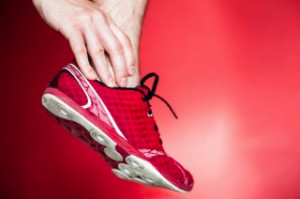 If you are a runner looking for the ideal pair of shoes that best fit your specific needs, it may help to have an understanding of the different parts of a running shoe and what they do. The “upper” is any part of the shoe above the sole. When shoe shopping, you should look for shoes with an upper that is smooth and shaped like your foot. The “ankle collar” is the wrap at the top part of the shoe opening. Its function is to hold the heel in place. You should look for an ankle collar that prevents your heel from slipping and sliding and doesn’t irritate the back of your ankle. The “toe box” encompasses the area between the laces and the front of the shoe. Look for a toe box that allows your toes to flex and spread out, without rubbing against it. To learn more about how to find the right running shoes, please consult with a podiatrist.
If you are a runner looking for the ideal pair of shoes that best fit your specific needs, it may help to have an understanding of the different parts of a running shoe and what they do. The “upper” is any part of the shoe above the sole. When shoe shopping, you should look for shoes with an upper that is smooth and shaped like your foot. The “ankle collar” is the wrap at the top part of the shoe opening. Its function is to hold the heel in place. You should look for an ankle collar that prevents your heel from slipping and sliding and doesn’t irritate the back of your ankle. The “toe box” encompasses the area between the laces and the front of the shoe. Look for a toe box that allows your toes to flex and spread out, without rubbing against it. To learn more about how to find the right running shoes, please consult with a podiatrist.
If you are a runner, wearing the right running shoe is essential. For more information, contact Mark Isenberg, DPM from Center for Podiatric Excellence. Our doctor can provide the care you need to keep you pain-free and on your feet.
Choosing the Right Running Shoe for Your Foot Type
To increase performance and avoid the risk of injury, it is important to choose the right running shoe based on your foot type. The general design of running shoes revolves around pronation, which is how the ankle rolls from outside to inside when the foot strikes the ground.
- Neutral runners are able to choose from a wide variety of shoes, including minimalist shoes or even going barefoot.
- Runners who overpronate, or experience an over-abundance of ankle rolling, should choose shoes that provide extra motion control and stability.
- Runners who underpronate, or supinate, have feet that have high arches and lack flexibility, preventing shock absorption. They require shoes with more flexibility and cushion.
If you have any questions please feel free to contact our office located in Pensacola, FL . We offer the newest diagnostic and treatment technologies for all your foot and ankle needs.
Choosing the Right Running Shoe for Your Foot Type
Running may seem like a simple to do. However, running is actually a complex movement that puts stress on the ligaments, bones, and joints of the body. Selecting the correct running shoe is important for increasing performance and avoiding risk of injury. Running shoes should be selected based on your foot type. Considerations such as trail versus road shoes are important. Your foot type dictates the degree of cushioning, stability and motion control you require. The most accurate way to learn your foot type is to visit a local shop that specializes in running shoes. Professionals can measure your arch type, stride and gait and help you with your shoe needs.
The design of running shoes is created around the idea of pronation. Pronation is the natural rolling movement of your ankle from the outside to inside when your foot strikes the ground. If you run properly you strike the ground on the outside of your heel and roll in the direction of your big toe before pushing off once more. Pronation is beneficial because it assists the lower half of your body in absorbing shock and storing energy. Those considered neutral runners pronate correctly and do not need running shoes that help correct their form. Neutral runners can choose from a wide variety of shoes, including barefoot or minimal types. However, those who have arch problems or who adopt an incorrect form while running may experience too much or too little pronation. They may require running shoes that offer additional support.
Those who overpronate experience an over-abundance of ankle rolling. Even while standing, those who severely overpronate display ankles that are angled inward. It is not uncommon for them to have flat feet or curved legs. The tendency to overpronate may cause many injuries. Areas that tend to become injured are the knees, ankles, and Achilles tendon. If you find that you have a tendency to overpronate, you should look at shoes that provide extra stability and motion-control. Motion-control shoes are straight and firm. Shoes of this type do not curve at the tip. The restricted flexibility along the middle of the shoe prohibits the foot from rolling too far inward as your foot strikes the ground.
A less common problem is underpronation. Underpronation, also called supination, is when the feet are unable to roll inward during landing. Those who underpronate have feet that lack flexibility and high arches. This prevents any kind of shock absorption, even though it does place less rotational stress on ankles and knees. This added force can cause fractures, ligament tears, and muscle strains because the legs are trying to compensate for the impact. Those who underpronate need shoes with more cushioning and flexibility. If you have a tendency to underpronate, selecting stability or motion-control shoes may cause you more problems by continuing to prevent pronation.
Vascular Testing For Peripheral Artery Disease
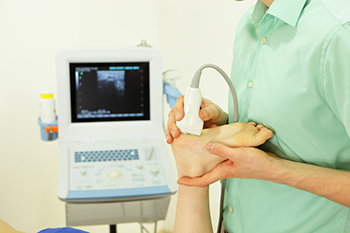 Poor circulation in the lower limbs can be a sign of peripheral artery disease (PAD). This is a serious condition that can cause leg cramps, muscle weakness, numbness, tingling, foot and ankle wounds, and difficulty walking. Older individuals and those with a history of cardiovascular problems are said to be particularly at risk. Your podiatrist can play a major role in detecting, diagnosing, and helping you manage PAD. Podiatrists can perform diagnostic vascular tests in the clinic. These tests are safe and noninvasive ways to assess blood flow in your lower limbs. Frequently used tests include the Ankle-Brachial Index test and Doppler ultrasonography. To learn more about PAD and to get tested, schedule an appointment with a podiatrist near you.
Poor circulation in the lower limbs can be a sign of peripheral artery disease (PAD). This is a serious condition that can cause leg cramps, muscle weakness, numbness, tingling, foot and ankle wounds, and difficulty walking. Older individuals and those with a history of cardiovascular problems are said to be particularly at risk. Your podiatrist can play a major role in detecting, diagnosing, and helping you manage PAD. Podiatrists can perform diagnostic vascular tests in the clinic. These tests are safe and noninvasive ways to assess blood flow in your lower limbs. Frequently used tests include the Ankle-Brachial Index test and Doppler ultrasonography. To learn more about PAD and to get tested, schedule an appointment with a podiatrist near you.
Vascular testing plays an important part in diagnosing disease like peripheral artery disease. If you have symptoms of peripheral artery disease, or diabetes, consult with Mark Isenberg, DPM from Center for Podiatric Excellence. Our doctor will assess your condition and provide you with quality foot and ankle treatment.
What Is Vascular Testing?
Vascular testing checks for how well blood circulation is in the veins and arteries. This is most often done to determine and treat a patient for peripheral artery disease (PAD), stroke, and aneurysms. Podiatrists utilize vascular testing when a patient has symptoms of PAD or if they believe they might. If a patient has diabetes, a podiatrist may determine a vascular test to be prudent to check for poor blood circulation.
How Is it Conducted?
Most forms of vascular testing are non-invasive. Podiatrists will first conduct a visual inspection for any wounds, discoloration, and any abnormal signs prior to a vascular test.
The most common tests include:
- Ankle-Brachial Index (ABI) examination
- Doppler examination
- Pedal pulses
These tests are safe, painless, and easy to do. Once finished, the podiatrist can then provide a diagnosis and the best course for treatment.
If you have any questions, please feel free to contact our office located in Pensacola, FL . We offer the newest diagnostic and treatment technologies for all your foot care needs.
Vascular Testing in Podiatry
In foot care, vascular testing may be required in the diagnosing and treatment of certain podiatric conditions. Vascular testing is particularly relevant for patients with high-risk diabetes, poor circulation, peripheral artery disease (PAD), and chronic venous insufficiency (CVI). Procedures typically involve the examination of blood vessels throughout the body for blockages or buildup.
Vascular testing is very important for the diagnosis of various conditions, including peripheral artery disease and chronic venous insufficiency, as these conditions can greatly affect one’s quality of life and cause pain in the lower limbs. Circulatory problems in the feet and ankles can reflect issues throughout the body, making testing of the blood vessels pertinent.
Testing methods vary between practitioners and can be specific to certain foot and ankle problems. Modern technology has brought about the ability to perform vascular testing using non-invasive methods, such as the cuff-based PADnet testing device. This device records the Ankle-Brachial Index (ABI)/Toe-Brachial Index (TBI) values and Pulse Volume Recording (PVR) waveforms. Contact your podiatrist to determine what vascular testing is available for your needs.
What Are the Symptoms of an Ingrown Toenail?
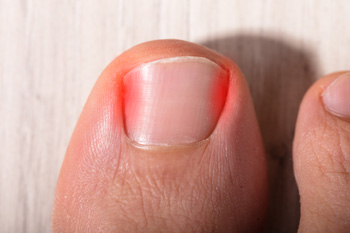 The big toe is most commonly affected when an ingrown toenail develops. An ingrown toenail is defined as the nail growing into the skin instead of over it. This can develop for several reasons including a recent toe injury, wearing shoes that do not fit properly, or from trimming the toenails incorrectly. A common symptom of this condition is pain in the big toe and surrounding areas, followed by redness and swelling. Mild relief may be found when the affected toe is soaked in warm water, and this can make it easier to gently pull the skin away from the toenail. It is also beneficial to wear shoes that have ample room for the toes to move freely in, in addition to refraining from putting pressure on the ingrown toenail. If you have symptoms of an ingrown toenail it is strongly suggested that you meet with a podiatrist who can effectively treat this condition.
The big toe is most commonly affected when an ingrown toenail develops. An ingrown toenail is defined as the nail growing into the skin instead of over it. This can develop for several reasons including a recent toe injury, wearing shoes that do not fit properly, or from trimming the toenails incorrectly. A common symptom of this condition is pain in the big toe and surrounding areas, followed by redness and swelling. Mild relief may be found when the affected toe is soaked in warm water, and this can make it easier to gently pull the skin away from the toenail. It is also beneficial to wear shoes that have ample room for the toes to move freely in, in addition to refraining from putting pressure on the ingrown toenail. If you have symptoms of an ingrown toenail it is strongly suggested that you meet with a podiatrist who can effectively treat this condition.
Ingrown toenails may initially present themselves as a minor discomfort, but they may progress into an infection in the skin without proper treatment. For more information about ingrown toenails, contact Mark Isenberg, DPM of Center for Podiatric Excellence. Our doctor can provide the care you need to keep you pain-free and on your feet.
Ingrown Toenails
Ingrown toenails are caused when the corner or side of a toenail grows into the soft flesh surrounding it. They often result in redness, swelling, pain, and in some cases, infection. This condition typically affects the big toe and may recur if it is not treated properly.
Causes
- Improper toenail trimming
- Genetics
- Improper shoe fitting
- Injury from pedicures or nail picking
- Abnormal gait
- Poor hygiene
You are more likely to develop an ingrown toenail if you are obese, have diabetes, arthritis, or have any fungal infection in your nails. Additionally, people who have foot or toe deformities are at a higher risk of developing an ingrown toenail.
Symptoms
Some symptoms of ingrown toenails are redness, swelling, and pain. In rare cases, there may be a yellowish drainage coming from the nail.
Treatment
Ignoring an ingrown toenail can have serious complications. Infections of the nail border can progress to a deeper soft-tissue infection, which can then turn into a bone infection. You should always speak with your podiatrist if you suspect you have an ingrown toenail, especially if you have diabetes or poor circulation.
If you have any questions, please feel free to contact our office located in Pensacola, FL . We offer the newest diagnostic and treatment technologies for all your foot care needs.
Blog Archives
- September 2025
- August 2025
- July 2025
- June 2025
- May 2025
- April 2025
- March 2025
- February 2025
- January 2025
- December 2024
- November 2024
- October 2024
- September 2024
- August 2024
- July 2024
- June 2024
- May 2024
- April 2024
- March 2024
- February 2024
- January 2024
- December 2023
- November 2023
- October 2023
- September 2023
- August 2023
- July 2023
- June 2023
- May 2023
- April 2023
- March 2023
- February 2023
- January 2023
- December 2022
- November 2022
- October 2022
- September 2022
- August 2022
- July 2022
- June 2022
- May 2022
- April 2022
- March 2022
- February 2022
- January 2022
- December 2021
- November 2021
- October 2021
- September 2021
- August 2021
- July 2021
- June 2021
- May 2021
- April 2021
- March 2021
- February 2021
